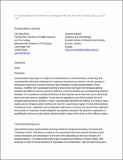Nonassociative Learning
| dc.contributor.author | Schmid, Susanne | |
| dc.contributor.author | Poon, Chi-Sang | |
| dc.date.accessioned | 2012-02-16T18:18:03Z | |
| dc.date.available | 2012-02-16T18:18:03Z | |
| dc.date.issued | 2012-01 | |
| dc.identifier.isbn | 978-1-4419-1428-6 | |
| dc.identifier.isbn | 978-1-4419-1427-9 | |
| dc.identifier.uri | http://hdl.handle.net/1721.1/69128 | |
| dc.description.abstract | Nonassociative learning is an implicit (non-declarative) or procedural form of learning that systematically attenuates (habituates) or augments (sensitizes) an animal’s sensory percept or behavioral response to a sensory stimulus upon repeated or continual presentation of the stimulus. It differs from associative learning in that it does not require the temporal pairing between two different sensory stimuli or between a sensory stimulus and corresponding response feedback. It is considered a fundamental form of learning that can be observed across all animal phyla and most sensory modalities. It may also be regarded as one of the simplest forms of unsupervised learning in animals, in that it automatically classifies the valence of a sensory input based upon its temporal pattern without the need for a supervisory signal. In most animal species including humans, habituation and sensitization take place in sensory and sensorimotor pathways and provide an important central adaptation and gating mechanism for selective suppression or amplification of sensory information reaching higher centers of the brain or their effector organs. | en_US |
| dc.language.iso | en_US | |
| dc.publisher | Springer-Verlag | en_US |
| dc.relation.isversionof | http://dx.doi.org/10.1007/978-1-4419-1428-6_1849 | en_US |
| dc.rights | Article is made available in accordance with the publisher's policy and may be subject to US copyright law. Please refer to the publisher's site for terms of use. | en_US |
| dc.source | Chi-Sang Poon | en_US |
| dc.title | Nonassociative Learning | en_US |
| dc.type | Book chapter | en_US |
| dc.identifier.citation | Kirchkamp, Oliver et al. “Nonassociative Learning.” Encyclopedia of the Sciences of Learning. Ed. Norbert M. Seel. Boston, MA: Springer US, 2012. 2475-2477. Web. 16 Feb. 2012. | en_US |
| dc.contributor.department | Harvard University--MIT Division of Health Sciences and Technology | en_US |
| dc.contributor.approver | Poon, Chi-Sang | |
| dc.contributor.mitauthor | Poon, Chi-Sang | |
| dc.relation.journal | Encyclopedia of the Sciences of Learning | en_US |
| dc.eprint.version | Author's final manuscript | en_US |
| dc.type.uri | http://purl.org/eprint/type/BookItem | en_US |
| dspace.orderedauthors | Kirchkamp, Oliver; Nagel, Rosemarie Chariklia; Sarin, Rajiv; Montuori, Alfonso; Rowe, Jonathan; Mott, Bradford; Lester, James; Armstrong, J. Scott; Spector, Michael J.; Burns, George W.; Cindio, Fiorella; Peraboni, Cristian; Cerri, Stefano A.; Bernasconi, Michele; Galizzi, Matteo Maria; Courtin, Julien; Gonzalez-Campo, Cecilia; Herry, Cyril; Psotka, Joseph; Kim, Sung-il; Cross, Emily S.; Ramsey, Richard; Waters, Allison C.; Tucker, Don M.; Everhart, D. Erik; Jozefowiez, Jeremie; Chandler, Rebecca A.; Ebmeier, Klaus P.; Stewart, Mary E.; Bier, Nathalie; Adam, Stéphane; Meulemans, Thierry; Belliotti, Raymond Angelo; Poon, Chi-Sang; Schmid, Susanne; Illeris, Knud; Kalish, Charles; Laakso, Mikko-Jussi; Rajala, Teemu; Kaila, Erkki; Salakoski, Tapio; Brannon, Elizabeth M. | en |
| mit.license | PUBLISHER_POLICY | en_US |
| mit.metadata.status | Complete |
